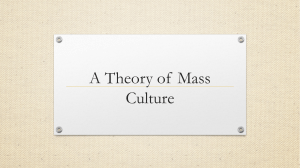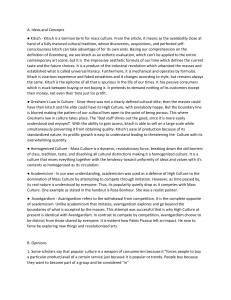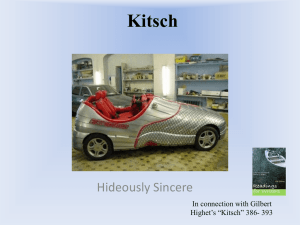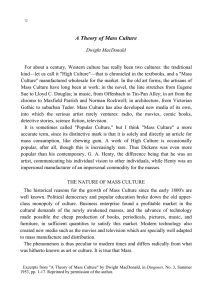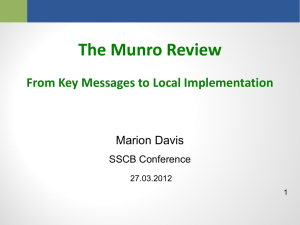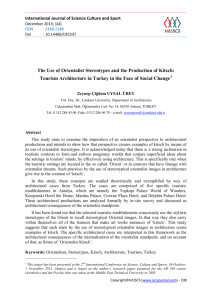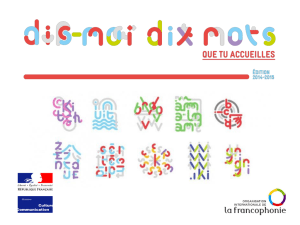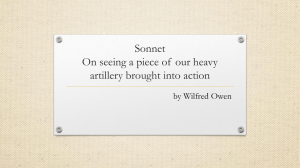Social Science and Knowledge
advertisement
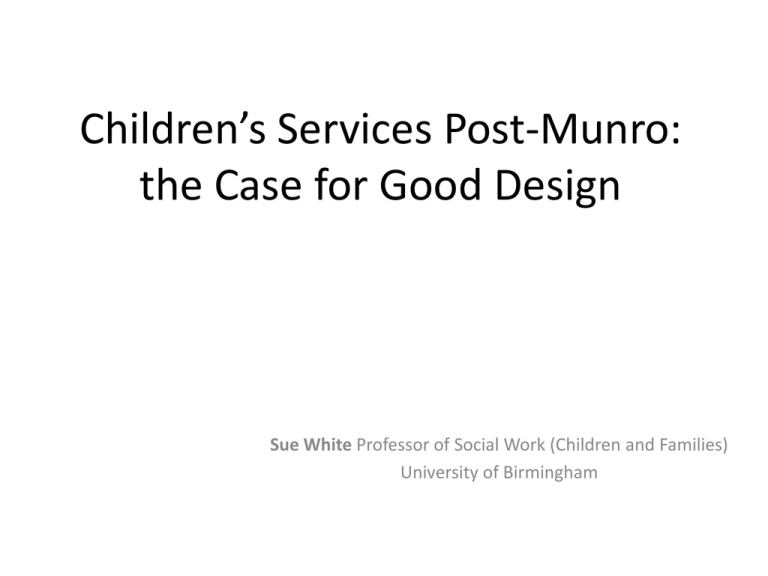
Children’s Services Post-Munro: the Case for Good Design Sue White Professor of Social Work (Children and Families) University of Birmingham In the past, problems have too often led to more central prescription, culminating in the current over-proceduralised system. This review proposes an alternative view: that the system is complex and it is not possible to predict or control it with precision (Munro, 2011). Poor design..... Assumptions of Policy Responses • People need extrinsic motivation to do a good job • Strong top-down management is the key to quality and performance; • Standardisation of processes and explicit targets drive quality – ‘doing simple things right’, • Aided by rigorous micro-management of processes and outputs via comprehensive systems of performance indicators – ‘deliverology’ • That errors are a result of professionals failing to share or record information • Efficiency is privileged over ‘reliability’ • That technologies including ICTs are integral to this reform agenda ... unlike cancer, serious harm [to a vulnerable person] can only be known once it has happened. And we are then in the position of looking backwards, not forwards, looking for evidence after the event...Looking back, something will always be found which would seem to provide advance knowledge of impending catastrophe. But to be sure that this evidence is decisive, we need to know how often it was present in other cases but did not lead to calamity. Designing on the basis of retrospective correlation is a recipe for disaster, intrinsically linked with magical thinking, but unfortunately in the domain of child protection it is the norm (David Wastell, Managing as Designing in the Public Services, forthcoming 2011). Systems must be Designed for the Right Species • Information processing • Emotion/moral judgement • Group think, bystander effect The Way Forward...? • • • • • • Requisite Variety - Only variety absorbs variety! Risk cannot be eliminated Rediscovery of ‘helping’ Local service design Human centred systems design Some corporate LG reforms place further barriers between social care and other professionals, individuals, communities and families What sort of Management? Lessons from the Factory Age.... Robert Owen, management pioneer, and social reformer of the early factory age When it was known in Manchester that Mr. Drinkwater had engaged me, a mere boy without experience, to take the entire direction of this new mill, the leading people thought he had lost his senses… I at once determined to do the best I could and began to examine the outline and detail of what was in progress. I looked grave, inspected everything very minutely, examined the drawings and the calculations of the machinery. I was in with the first in the morning, and I locked up the premises at night. I continued this silent inspection for six weeks .. and during that period I did not give one direct order about anything. But at the end of that time I felt myself so much master of my position, as to be ready to give directions in every department.... I soon perceived the defects in the various processes and improved the quality of our manufacture. Robert Owen was a Designer. Choose Design not Kitsch Design thinking and systems thinking are one and the same. In great design, form and function come together seamlessly. Every part contributes to the whole in a way that seems inevitable. So too in a great system. Hence I’ve coined the term beautiful system (Peters, 2005, p. 54) Precisely by deflecting the creative and the uncertain, kitsch advances the repetitive, the secure and the comfortable, supplying the reassurance that what is to come will resemble what has gone before, that the hazards of innovation and uncertainty are far away, and that one is safe and secure in the routines of an unadventurous genre (Binkley, 2000, pp. 135-6) So you want to understand an aircraft carrier? Well, just imagine that it's a busy day, and you shrink San Francisco Airport to only one short runway and one ramp and gate. Make planes take off and land at the same time, at half the present time interval, rock the runway from side to side, and require that everyone who leaves in the morning returns that same day. Then turn off the radar to avoid detection, impose strict controls on radios, fuel the aircraft in place with their engines running, put an enemy in the air, and scatter live bombs and rockets around. Now wet the whole thing down with salt water and oil, and man it with 20-year-olds, half of whom have never seen an airplane close-up. Oh, and by the way, try not to kill anyone. Senior officer, Air Division No armchair designer, even one with extensive carrier service, could sit down and lay out all the relationships and interdependencies, let alone the criticality and time sequence of all the individual tasks. Both tasks and coordination have evolved through the incremental accumulation of experience to the point where there probably is no single person in the Navy who is familiar with them all Organizations in which reliability is a more pressing issue than efficiency have unique problems in learning… trial and error is not available to them. Substitutes for trial and error come in the form of imagination, stories, simulations. The basic idea is that a system which values stories, story-tellers will be more reliable than one which derogates these… because people know more about their system, of the errors that might occur…. Karl Weick 1987 What Happens when we ‘design’ locally? Cumbria’s Vanguard ‘Check’ Only 47% of their work was ‘value’ work 53% was ‘waste’ – either failure demand or activity that does not add value – how many ‘touches’ before a family gets a service? Ditch the Kitsch! • Ask yourselves how much time you routinely spend getting to know the practice and the needs in your area of responsiblity? How much do you watch, listen and learn, before you rush to implementation/procurement? • An up- close-and-personal eye on the real work – what your organisation is trying to achieve for individuals and families is vital. • This should be your day job – you can innovate you can design, you can argue your case • Kitsch is the enemy of creativity. Do a kitsch audit and sling it out! (From Wastell and White, 2011, Managers as systems designers: towards a new relationship with technology, Community Care Inform) Accountability and Outcomes • Munro stresses the need for different models for judging service effectiveness • Inspectorates are still working within a particular output-focused paradigm • Beware of proxies for success (e.g. Narrowly specified activities which stifle innovations for providers; indicator sets) • Interrogate claims that interventions are evidence based – look at the evidence – because it works in the US with a selected sample population and rigid exclusion criteria doesn’t mean it will work for your children and families • Children, young people, families and providers can help identify indicators • For commissioners - don’t suck resource out of provider agencies by excessive and unfunded data demands In the astral zones where ‘policy elites’ devise reform, the importance of understanding the need for design is critical, and ignorance of it is the cause of much mischief... In practical terms, moving from delivery to design requires the opening up of ‘creative space’ at the local level, the freedom (and responsibility) to experiment and to tailor bespoke solutions that reflect local contingencies, preferences and modes of working (Wastell, 2011: 176). A useful book for designers
